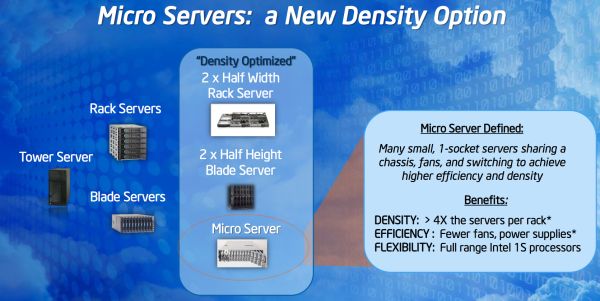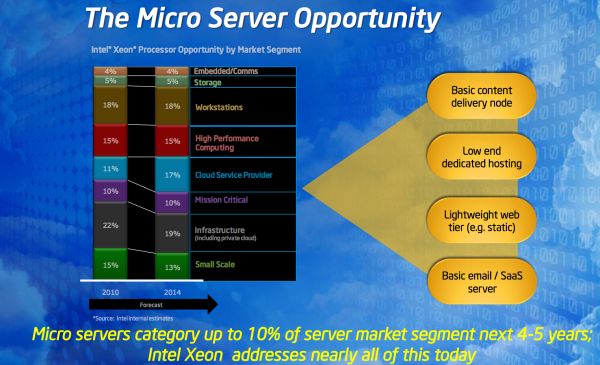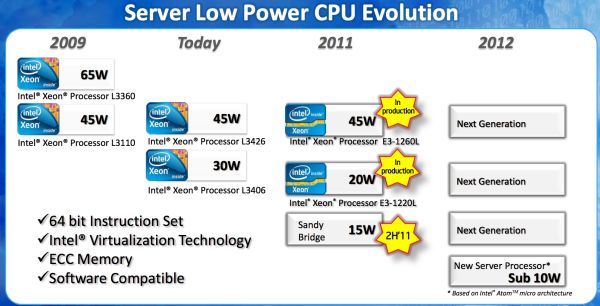Intel Plans on Bringing Atom to Servers in 2012, 20W SNB Xeons in 2011
by Anand Lal Shimpi on March 15, 2011 2:35 PM EST- Posted in
- IT Computing
- CPUs
- Intel
- Atom
- Xeon
The transition to smaller form factors hasn't been exclusively a client trend over the past several years, we've seen a similar move in servers. The motiviation is very different however. In the client space it's about portability, in the datacenter it's about density. While faster multi-core CPUs have allowed the two-socket 1U server to really take off, they have also paved the way for a new category of density optimized servers: the micro server.
The argument for micro servers is similar to that for ultra low power clients. Only a certain portion of workloads really require high-end multi-socket servers, the rest spend much of their time idle and thus are better addressed by lower power, higher density servers. Johan typically argues that rather than tackling the problem with micro servers it's a better idea to simply increase your consolidation ratio into fewer, larger servers. There are obviously proponents on both sides of the fence but Intel estimates that the total market for micro servers will reach about 10% of its total shipments over the next 4 - 5 years. It's a small enough market for Intel not to be super concerned about but large enough that it needs to be properly addressed.
Today Intel believes that it addresses this market relatively well with the existing Xeon lineup. Below is a table of Sandy Bridge Xeons including a 45W and 20W part, these two being directed primarily at the micro server market:
| Intel SNB Xeon Lineup | ||||||||
| Intel Xeon Processor Number | Cores / Threads | Clock Speed | Single Core Max Turbo | L3 Cache | Memory Support (Channels / DIMMs / Max Capacity) | Power (TDP) | ||
| E3-1280 | 4 / 8 | 3.50GHz | 3.90GHz | 8MB | 2 / 4 / 32GB | 95W | ||
| E3-1270 | 4 / 8 | 3.40GHz | 3.80GHz | 8MB | 2 / 4 / 32GB | 80W | ||
| E3-1260L | 4 / 8 | 2.40GHz | 3.30GHz | 8MB | 2 / 4 / 32GB | 45W | ||
| E3-1240 | 4 / 8 | 3.30GHz | 3.70GHz | 8MB | 2 / 4 / 32GB | 80W | ||
| E3-1230 | 4 / 8 | 3.20GHz | 3.60GHz | 8MB | 2 / 4 / 32GB | 80W | ||
| E3-1220L | 2 / 4 | 2.20GHz | 3.40GHz | 3MB | 2 / 4 / 32GB | 20W | ||
| E3-1220 | 4 / 4 | 3.10GHz | 3.40GHz | 8MB | 2 / 4 / 32GB | 80W | ||
Drop clock speed (and voltage) low enough and you can hit the lower TDPs necessary to fit into a micro server. Thermal constraints are present since you're often cramming a dozen of these servers into a very small area.
Long term there is a bigger strategy issue that has to be addressed. ARM has been talking about moving up the pyramid and eventually tackling the low end/low power server market with its architectures. While Xeon can scale down, it can't scale down to the single digit TDPs without serious performance consequences. Remember the old rule of thumb: a single microprocessor architecture can only address an order of magnitude of TDPs. Sandy Bridge can handle the 15 - 150W space, but get too much below 15W and it becomes a suboptimal choice for power/performance.
The solution? Introduce a server CPU based on Intel's Atom architecture. And this is the bigger part of the announcement today. Starting in 2012 Intel will have an Atom based low power server CPU with sub-10W TDPs designed for this market. Make no mistake, this move is designed to combat what ARM is planning. And unlike the ultra mobile space, Intel has an ISA advantage in the enterprise market. It'll be tougher for ARM to move up than it will be for Intel to move down.
Intel's slide above seems to imply that we'll have ECC support with this server version of Atom in 2012, which is something current Atom based servers lack.
The only real question that remains is what Atom architecture will be used? We'll see an updated 32nm Atom by the end of 2011 but that's still fundamentally using the same Bonnell core that was introduced back in 2008. Intel originally committed to keeping with its in-order architecture for 5 years back in 2008, that would mean that 2012 is ripe for the introduction of an out-of-order Atom. Whether or not that updated core will make it in time for use in Atom servers is still up for debate.













53 Comments
View All Comments
PhilipHa - Wednesday, March 16, 2011 - link
Clearly Intel is trying to counteract upcoming ARM based servers, including those from Marvell and Nvidia.Calxeda claims to be working on quad-ARM-A9 server nodes with less than 5W TDP including memory, and up to 480 cores in a 2U form factor. ( http://www.zdnet.co.uk/blogs/mapping-babel-1001796... )
I guess the problem for Intel is that it needs to cover this potential market whether it is realised or not. Intel's big problem is that this has the potential to significantly reduce margins in their server business. Some claim such ARM servers will produce 5x to 10x performance per watt, and 15x to 20x better price performance. ( http://www.eetimes.com/electronics-news/4213963/Ca... ).
The other advantage the ARM eco-system has is that its cores can be tailored to specific requirements, so for example floating point silicon area could be reduced in favour of more cores and better integer performance in areas, for applications like web servers where floating point performance is not needed.
marc1000 - Wednesday, March 16, 2011 - link
I've read your link. there is an interesting part in it:"each node will consist of an ARM Cortex A9 quad-core CPU, DRAM and fabric interconnect , and will consume around 5W"
so, for 480cores you would need 120 quad-core nodes, that will consume 120*5W = 600W. this is in line with any multiple-cpus server.
take 4 quad-xeons (130w each), plus mobo and memory, and you are in the 600W arena in 2U space again.
there is simply a physical limit in doing calculationsby using electricity. it does not matter what kind of cpu you use, you will just need similar amounts of power to do similar amounts of calculations.
marc1000 - Wednesday, March 16, 2011 - link
that in the same process node, of course.MadMan007 - Thursday, March 17, 2011 - link
Whoever came up with the dumb-sh*t abbreviation 'SNB' for Sandy Bridge needs to die a in a fire.marc1000 - Thursday, March 17, 2011 - link
agreedgreenguy - Thursday, March 17, 2011 - link
This is more likely to combat what AMD is planning, which will (hopefully) be the release of a relatively low cost Llano with power gating on CPU core and GPU, with low idle power and ECC RAM support, which is what is needed in a home NAS or server. With all the video stuff on the APU and power gated, the total system power draw has potential to be very low.A system with ECC RAM is the perfect complement to NAS with ZFS RAID, ZFS ensuring that your data is as it should be, and the ECC RAM ensuring that any data that should be written is the correct data. And also ensuring that the system is running as it was coded to, without mysterious crashes.
UrQuan3 - Thursday, March 17, 2011 - link
I'm kind of late posting on this one, but oh well.An Atom-like server would have its uses. Twice in the last year I've had to spec a machine that needed tiny computation ability, but 60GB of ECC ram. The machine simply does not exist. Using a dual, quad-core Xeon for a que manager is painful, but there is currently no other way. The ram cannot be spared for adding VMs, so the cores just sit there. A single atom/bobcat/nano on a 64-bit ecc memory bus would be perfect.
dirk adamsky - Friday, March 18, 2011 - link
Hello all,HP already offers a low power cpu server, the HP Proliant n36L microserver based on the AMD Neo cpu.
I did combine the n36l microserver with a HP Smart Array p410 raid controller with 512MB cache (with battery)(controller price in the Netherlands is in or about 270 Euro (now already down to 250 euro)).
The setup is combined with 2 x 4Gb Kingston memory and 2 x 300GB WD Velociraptors.
I made 4 blog entries on installation, VMware ESXi installation, MS Win SBS 2011 installation, etc..
They first 2 can be found here:
http://deludi.nl/blog/vbscript/various/various-how...
http://deludi.nl/blog/vbscript/various/various-how...
Later I will post about running multiple vm's on the n36l.
Best regards,
dirk adamsky
krumme - Saturday, March 19, 2011 - link
One BD module, dualcore, is aprox 32mm2 sans L3, thats less than half a zakate...Is the nearest competitor for AMD BD Atom or SB then? - or ARM?
Soon Intel will realize the have a good SB cpu but without a profitable market for it
lili75 - Monday, March 21, 2011 - link
welcome